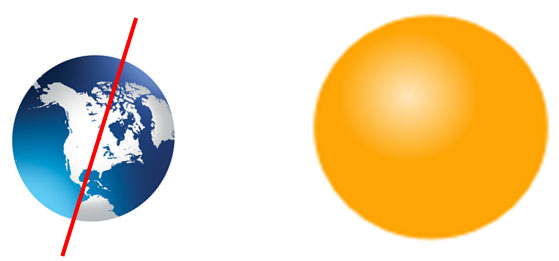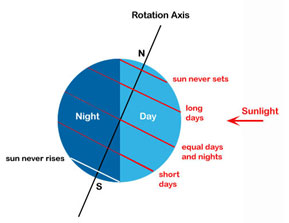
Source:
Earth on rotation on its axis,
Best Animations
The solar system is not simply a collection of stationary planets, moons, and other bodies around the sun. Each planet rotates, or spins, on its axis.
The rotation of the Earth on its axis causes day and night. As the Earth rotates, only one-half of the Earth faces the sun at any given time. The half facing the sun is light (day) and the half facing away from the sun is dark (night). The animation below shows the Earth's rotation.

Source:
Earth on rotation on its axis,
Best Animations
When viewed above the North Pole, the Earth rotates counterclockwise, from west to east. This is also called a prograde rotation. Because of this direction of rotation, we see the sun rising every day in the east and setting in the west. If a planet spins in a clockwise direction, it is said to have a retrograde rotation. Venus is an example of a planet with a retrograde rotation.
The Earth rotates on its axis once every 23 hours and 56 minutes. So does that mean that all places on Earth experience 12 hours of light and 12 hours of dark each day? If you think about it, you know that that is not true. During certain times of the year we have more hours of daylight than at other times. Why is this? The answer is that the Earth's axis is not at a right angle with the sun. It is tilted slightly at an angle of 23.5°. The diagram below shows Earth's tilt in relation to the sun.


Source: Earth on its Axis, Department of Astronomy and Astrophysics, Penn State University
Because of the tilt of Earth's axis, the amount of daylight varies throughout the year. The least amount of variation occurs at the equator while the most amount of variation occurs at the poles. Because of this wide variation, it is never completely dark at the poles in the summer nor completely light in the winter.
![]() The animation below correctly shows the rotation of Earth on its axis.
The animation below correctly shows the rotation of Earth on its axis.

Answer the following questions in your notes: